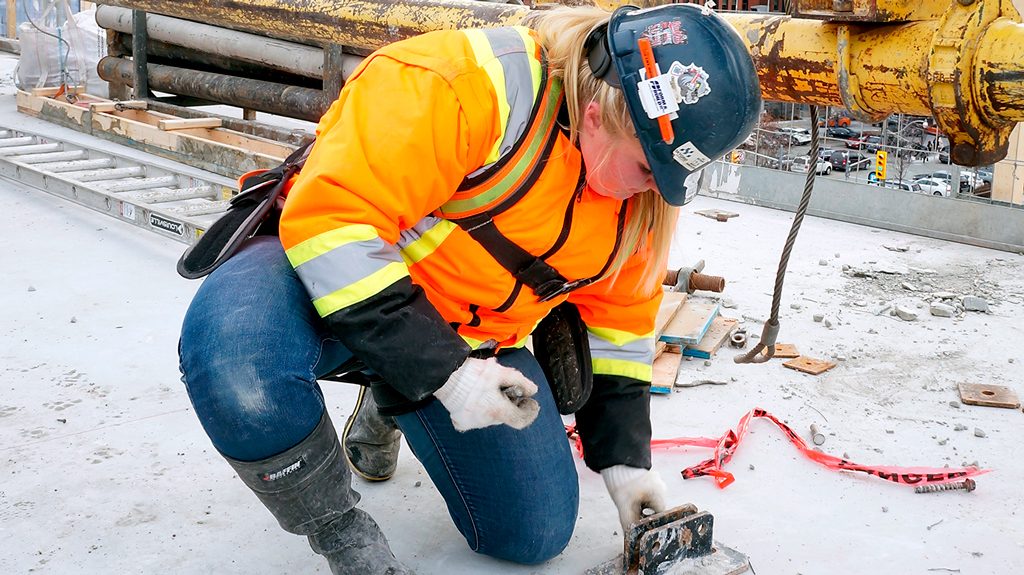The federal government needs to take necessary steps to develop a national maternity assistance program strategy to remove barriers for women and level the playing field in the trades, the Canadian operating officer of Canada’s Building Trades Unions (CBTU) recently told a senate committee on social affairs, science and technology.
Robert Blakely addressed the committee regarding private members Bill C-243, an Act Respecting the Development of a National Maternity Assistance Program Strategy. If adopted, the bill will develop a consultation process to set up a strategy.
“We want to see if there are some more effective ways to help the bright young women who opt for the trades get a fair shake when it comes to maternity issues,” said Blakely, adding the current system does not provide options for pregnant women who can’t stay in their job to leave without the loss of a paycheque.
The nature of construction work can put the health of the mother or child at risk, Blakely noted. Some trades are physically demanding, involve exposure to toxic substances, radioactive elements, or the weather, adding another challenge is every construction job is transitory and workers can be laid off at any time.
The CBTU currently has 500,000 members and only four per cent are female, Blakely noted. The baby boom generation is retiring in large numbers over the next few years which is expected to cause a labour shortage and the industry needs to replace 250,000 workers. Addressing maternity leave for tradeswomen and removing barriers is critical to attracting more women to the industry, he said.
“We are spending lots of time, money and effort to try and recruit bright young women into the business,” said Blakely. “If we are going to meet the challenge of getting 250,000 new people in the next five years that means we have to attract half a million and that means we fall on our face unless we get a substantial cohort of women. If they are going to come, they need to be properly supported.”
Most of the construction industry is made up of companies that employ fewer than 10 people, making accommodations for pregnant women challenging, Blakely pointed out.
Maternity and maternal care are among the key factors contributing to women leaving,
— Jeanette Southwood
Engineers Canada
“We have about 3,000 people working at Muskrat Falls, finding an accommodation for one person out of 3,000 is dead easy, to find a bundle of tasks in a trade that can make a meaningful job,” Blakely stated. “But if we’ve got three people building the garage in your backyard, the chances to be able to bundle duties to give somebody an accommodation is zip, zero, nothing.”
The evidence indicates where programs do exist, such as Quebec with the Safe Maternity Experience Program and the International Ironworkers’ recently implemented program, a small number of eligible candidates will actually use it.
“When you look at the number of women involved in this who may have to go earlier in their pregnancy than the traditional time that maternity leave kicks in, it’s not a huge cohort of people, so the cost isn’t very great,” said Blakely. “We need to find a way to protect them in the economic sense and in the social sense.”
Dr. Nicola Cherry, professor and tripartite chair of the occupational health division of preventative medicine at the University of Alberta, presented findings from studies conducted with women in the welding and electrical trades during pregnancy.
“It is very suggestive that women working in the trades are more likely to have a spontaneous abortion and that is true for both trades and particularly in fact for women in Alberta working in welding where the type of work they do is rather different than in perhaps Ontario,” explained Cherry. “They’re up in the oilfields, many of them, doing physically very challenging jobs. Having said that, we don’t find any evidence that women working in these trades have smaller babies, more premature babies, so if they get through the first three months the babies they produce seem to be just as healthy as those who are not working in those trades or who stopped work.”
She added, overall, 80 per cent of women in welding had stopped working in the trade by 28 weeks, before they were eligible for maternity benefits. Welders were less likely than other women to be reassigned partly because of the nature of the job.
Blakely said recent amendments to the Employment Insurance Act allows women the flexibility to take maternity leave early, but it does have implications after the baby is born as they are required to return to work earlier.
“That is a Band-Aid on a gushing wound,” said Blakely. “The truth is, if they take their maternity leave early, they are losing it on the other end. It has implications for breastfeeding, it has implications for familial and social situations, it creates issues for people around whether they can or should stay in their job. We have instances on a regular basis with women toughing it out, hiding their pregnancies, trying to work when they ought to be off.”
One of the issues with developing the strategy is the federal government only controls the Canada Labour Code, which covers nine per cent of Canada’s workforce.
“The research you’re going to commission, the consultations you’re going to do is, in our view, really essential to getting us to the next step,” said Blakely. “We will bundle duties and we will accommodate people insofar as we can and as unions, we have 175 training centres across the country. We will train people for other aspects of the job but people are going to need support to do that.”
Jeanette Southwood, vice-president of corporate affairs and strategic partnerships with Engineers Canada, who was representing the Canadian Coalition of Women in Engineering, Science, Trades and Technology, said women continue to be underrepresented in engineering with only 13.1 per cent of female practicing engineers in the field.
“Maternity and maternal care are among the key factors contributing to women leaving fields such as engineering, science, trades and technology,” said Southwood.
“A national strategy is needed to ensure Canada is positioned advantageously in a system that is fair for all.”
The bill is expected to go for third reading in the senate sometime in the new year.






Recent Comments